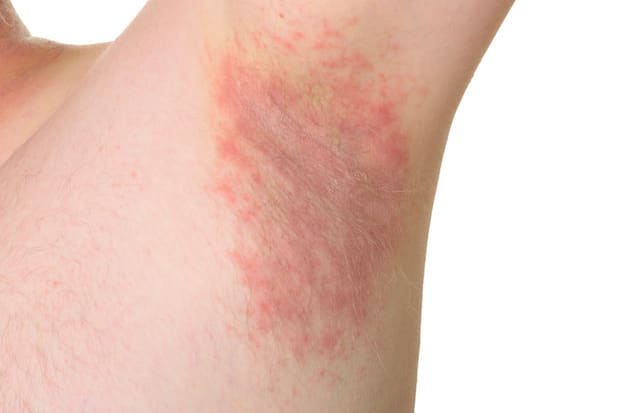Table of Contents
III. Athlete’s Foot & Jock Itch
a. Symptoms of Athlete's Foot and Jock Itch
IV. Yeast Infections of the Skin
a. Symptoms of Candidiasis of the Skin
What is a Skin Fungus?
The skin is the largest organ of the body, and several different conditions may affect it over a person's lifetime. The most common types include jock itch, ringworm, athlete's foot, and yeast infections. These infections are often itchy and annoying but rarely serious. Fungal skin infections do not usually spread beyond the skin. [1]
There are millions of different types of fungi that live around us at all times. They live in the dirt, plants, and household surfaces as well as the skin. Fungi thrive in dark and damp areas, and certain areas of the body can create the perfect environment for fungi to grow and proliferate.
These skin areas are often in the body’s folds, like the groin, armpits, and toes. Fungal skin infections are fairly common and usually cause rashes or bumps. Lotriderm cream (clotrimazole/betamethasone), Vermox (mebendazole), Spectazole (econazole), Diflucan (fluconazole), and Oxistat cream (oxiconazole) may be prescribed to treat the symptoms of fungal skin infections. Read on to learn more about the symptoms of these skin infections. [2]
Get savings updates for Diflucan
Understanding Ringworm
This type of fungal skin infection is caused by the tinea corporis fungus. Contrary to its name, ringworm does not involve any worm. It gets its name from the red ring it creates on the skin. Direct skin-to-skin contact is the most common mode of transmission for ringworm. Vermox (mebendazole) may be prescribed to clear up ringworm and its accompanying symptoms.

Ringworm may also spread by petting or grooming animals like dogs or cats. Cows are also known to carry ringworm. If you come into contact with objects that someone with ringworm has used, you may also contract the fungus. Common items that can transmit ringworm are clothing, towels, bedding, combs, and linens. Rarely, people get ringworm by coming in contact with infected soil. Risk factors for ringworm include:
- Wearing tight and restrictive clothing
- Having a weak immune system
- Living in a warm climate
- Participating in sports that involve skin-to-skin contact, like wrestling [3]
a. Symptoms of Ringworm
Ringworm can occur on several parts of the body and is closely related to athlete’s foot and jock itch. The symptoms of ringworm depend on which part of the body is affected. Generally, symptoms may include:
- Slightly raised, expanding rings
- Overlapping rings
- Itchiness at the affected area
- A round, flat patch of itchy skin
- Red bumps [3]
Ringworm on the scalp: If your scalp is affected, you may experience a patch on your head that is scaly, itchy, and red. It will create a circular bald spot, which grows in size and creates multiple spots on the scalp if the infection spreads. Children are more likely to get scalp ringworm.
Ringworm on the beard: Scaly, itchy, and red spots may occur on the cheeks, chin, and upper neck. They may become crusted over or filled with pus, and beard hair may fall out. [4]
Athlete’s Foot and Jock Itch
Ringworm, athlete's foot, and jock itch are all types of fungal skin infections known as tinea. Ringworm has its unique symptoms, whereas jock itch and athlete's foot have similar symptoms in different body areas.
As its name suggests, athlete's foot affects the soles of the feet, the areas between the toes, and the toenails. This fungal infection is common in those whose feet are often damp and sweaty, which is common for those who regularly participate in sports and other athletic activities. It is contagious and is usually spread through contaminated floors, towels, or clothing. This fungus causes a scaly red rash between the toes and may progress to blisters or ulcers. It can affect both feet and may spread to the hands. [5] Jock itch is very similar, causing a red and itchy rash in warm areas of the body. It is also common in athletes, overweight individuals, and those who sweat excessively. Jock itch is not a serious condition in the majority of cases and can be treated with antifungal medications like Spectazole (econazole). [6] Someone with athlete's foot may develop jock itch if they itch their foot and then touch their groin or thighs. Athlete's foot usually begins between the toes but may spread to the toenails and sole of the foot. The most common symptoms of athlete's foot include: Jock itch usually begins in the crease of the groin and may spread to the upper thigh in a half-moon shape. This rash may be ring-shaped and lined with small blisters. Itchiness, flakiness, and scaling may also occur. It is essential to keep jock itch as dry as possible to prevent prolonged symptoms. [6] Many different types of bacteria and fungi live on your skin, but infection may occur if these organisms begin to multiply uncontrollably. Candida is one such fungus that can cause unpleasant and possibly harmful symptoms. An infection caused by this fungus is known as cutaneous candidiasis. Like jock itch, cutaneous candidiasis most commonly occurs in the folds of the skin, causing a painful rash. The armpits, groin, between the fingers, and under the breasts are most likely to develop cutaneous candidiasis. Typically, this condition can be treated with improved hygiene habits and prescription antifungal drugs like Oxistat cream (oxiconazole). This condition is likely to occur if you: This condition looks similar to many skin problems like herpes, hives, eczema, and ringworm. It is essential to visit a doctor for a proper diagnosis to receive the proper treatment plan. The most common symptom is a rash. This rash can cause excessive itching and redness. If you have the rash for a prolonged period, the skin may become cracked and lead to blisters and pustules. Unlike the other fungal skin infections, candidiasis is not as contagious for the average healthy person. Those with a compromised immune system are more likely to transmit or contract this condition from another person. [8] Many fungal skin infections may look alike and cause similar symptoms, so a diagnosis may be difficult at first. Over-the-counter medications are often the first line of defense, but if you want to see a doctor, you may want to make a detailed list of your symptoms to make the most of your appointment. If your doctor is unsure, they may take a skin sample for testing. If your fungal skin infection is not reacting well to at-home remedies or over-the-counter sprays or powders, you may have to take prescription antifungal pills or creams like Diflucan (fluconazole) or Lotriderm cream (clotrimazole/betamethasone). These prescription drugs should clear up the rash and other symptoms within a few weeks. Fungal infections may occur again at any time, so it is essential to change any of the lifestyle habits that put you at risk for fungus development. This may include protecting your feet in public areas and wearing well-ventilated shoes. Talk to your doctor if you want to learn more about how to prevent fungal skin infections. [9] The content in this article is intended for informational purposes only. This website does not provide medical advice. In all circumstances, you should always seek the advice of your physician and/or other qualified health professionals(s) for drug, medical condition, or treatment advice. The content provided on this website is not a substitute for professional medical advice, diagnosis, or treatment.
a. Symptoms of Athlete's Foot and Jock Itch
Yeast Infections of the Skin

a. Symptoms of Candidiasis of the Skin
Diagnosis and Treatment
